This article relies largely or entirely on a single source .(July 2020) |
Robert of Burgate was a 13th-century landowner, nobleman, and household knight for John, King of England. [1] [2]
This article relies largely or entirely on a single source .(July 2020) |
Robert of Burgate was a 13th-century landowner, nobleman, and household knight for John, King of England. [1] [2]
Robert was born in 1180, and was a minor knight who held two knighthood fiefs in Burgate, Suffolk. [3] By 1205, the barony Honour of Eye was in the hands of the King John's half-brother William Longespée, 3rd Earl of Salisbury. [3] That year, Robert and his squire William Talbot made a pledge of surety for the earl of two casks of wine. [3] Robert was probably able to use his association with the Earl of Longsword as a stepping stone to the royal court. [4]
In 1208, Robert acquired the Honour of Eye (presumably as an administrator) through his service to the royal household. [4] Closely associated with the earl, he was frequently mentioned in documents. [4] Robert was responsible for collecting the earl's monetary payment (known as a money fief) from the exchequer in 1210, [4] and the earl was one of the men who vouched for Robert's ability to pay the 700 marks for his marriage to Gallena Dammartin. [4] The king's half-brother, the Earl of Longsword's word carried weight; his decision to vouch for Robert implies that they were close.
By 1210, Robert helped the king pay imprests (petty cash) and wages for troops for the campaign in Ireland. [4] Although he held a significant amount of land in Suffolk, he gained additional property there through his wife. [5] Robert was also known to have had acquired several manors and estates for his service to the crown; [6] during his career, he acquired the great house of Wascheth in Oxfordshire and the manor of Daventry. [6]
Robert was the king's paymaster and commander of his sergeants in 1213, and was ordered to prepare for an expected French invasion. [5] He was often employed to handle the king's financial matters. [7] Robert was appointed castellan of Dover Castle from 1211 to 1213, although William Talbot may have been the de facto castellan.
Around 1215, he became part of a diplomatic mission to Otto of Brunswick. [8] In 1216, Robert and fellow knights Engelram de Furnet and Gilbert de Sanes were given custody of Framlingham Castle (a confiscated rebel castle). He was ordered to return to the king's side, leaving the other two knights to manage the castle (presumably because Robert was one of the king's closest men). At some point in King John's reign, Robert was custodian of the archbishop of York and of the castle and Honour of Knaresborough during Brian de Lisle's brief estrangement from the king. [9]
Robert married Gallena Dammartin Brewern, widow of John Brewer and heir of William de Dammartin, and they had three sons. [8] He died in 1220, at age 40.

The Battle of Bouvines was fought on 27 July 1214 near the town of Bouvines in the County of Flanders. It was the concluding battle of the Anglo-French War of 1213–1214. Although estimates on the number of troops vary considerably among modern historians, at Bouvines, a French army commanded by King Philip Augustus routed a larger allied army led by Holy Roman Emperor Otto IV in one of the rare pitched battles of the High Middle Ages and one of the most decisive medieval engagements.

John Howard, 1st Duke of Norfolk, also known as Jack of Norfolk,, was an English nobleman, soldier, politician, and the first Howard Duke of Norfolk. He was a close friend and loyal supporter of King Richard III, with whom he was slain at the Battle of Bosworth in 1485.
John de Gray or de Grey was an English prelate who served as Bishop of Norwich, and was elected but unconfirmed Archbishop of Canterbury. He was employed in the service of Prince John even before John became king, for which he was rewarded with a number of ecclesiastical offices, culminating in his pro forma election to Norwich in 1200. De Gray continued in royal service after his elevation to the episcopate, lending the King money and undertaking diplomatic missions on his behalf. In 1205 King John attempted to further reward de Gray with a translation to the archbishopric of Canterbury, but a disputed election process led to de Gray's selection being quashed by Pope Innocent III in 1206.
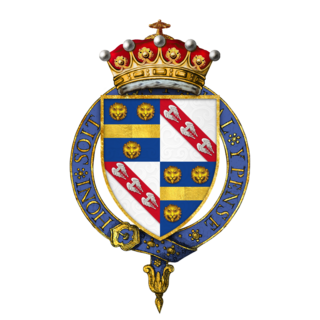
William de la Pole, 1st Duke of Suffolk,, nicknamed Jackanapes, was an English magnate, statesman and military commander during the Hundred Years' War. He became a favourite of the weak king Henry VI of England, and consequently a leading figure in the English government where he became associated with many of the royal government's failures of the time, particularly on the war in France. Suffolk also appears prominently in Shakespeare's Henry VI, parts 1 and 2.
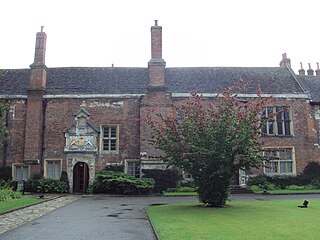
The Council of the North was an administrative body first set up in 1484 by King Richard III of England, to improve access to conciliar justice in Northern England. This built upon steps by King Edward IV of England in delegating authority in the north to Richard, duke of Gloucester, and in establishing the Council of Wales and the Marches.

William Longespée, 3rd Earl of Salisbury was an Anglo-Norman nobleman, primarily remembered for his command of the English forces at the Battle of Damme and for remaining loyal to his half-brother, King John. His nickname "Longespée" is generally taken as a reference to his great physical height and the oversize weapons that he used.

Sir Thomas Erpingham was an English soldier and administrator who loyally served three generations of the House of Lancaster, including Henry IV and Henry V, and whose military career spanned four decades. After the Lancastrian usurpation of the English throne in 1399, his career in their service was transformed as he rose to national prominence, and through his access to royal patronage he acquired great wealth and influence.
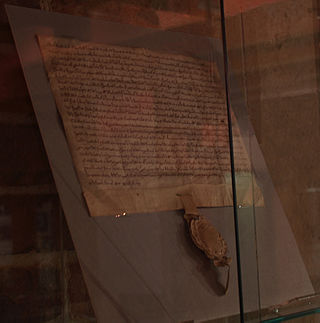
Sir William Longespée was an English knight and crusader, the son of William Longespée and Ela, Countess of Salisbury. His death became of significant importance to the English psyche, having died at the Battle of Mansurah, near Al-Mansurah in Egypt.
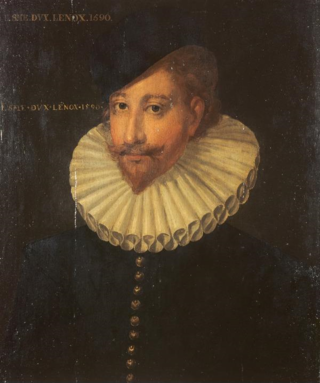
Esmé Stewart, 1st Duke of Lennox, 1st Earl of Lennox, 6th Seigneur d'Aubigny of the Château d'Aubigny at Aubigny-sur-Nère in the ancient province of Berry, France, was a Catholic French nobleman of Scottish ancestry who on his move to Scotland at the age of 37 became a favourite of the 13-year-old King James VI of Scotland. Esmé Stewart was the first cousin of James' father, Henry Stewart, Lord Darnley. Despite his conversion to Calvinism he was never trusted by the Scots and returned to France where he ended his days. Sir James Melville described him as "of nature upright, just and gentle". He was the first to popularise the firstname Esmé in the British Isles.
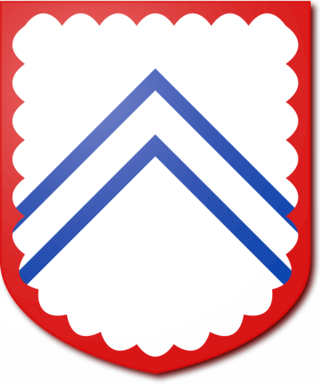
Sir John Tyrrell, of Heron in the Essex parish of East Horndon, was an English landowner, lawyer, administrator, and politician who was chosen three times as Speaker of the House of Commons.

Clare Castle is a high-mounted ruinous medieval castle in the parish and former manor of Clare in Suffolk, England, anciently the caput of a feudal barony. It was built shortly after the Norman Conquest of England in 1066 by Richard Fitz Gilbert, having high motte and bailey and later improved in stone. In the 14th century it was the seat of Elizabeth de Clare, one of the wealthiest women in England, who maintained a substantial household there. The castle passed into the hands of the Crown and by 1600 was disused. The ruins are an unusually tall earthen motte surmounted by tall remnants of a wall and of the round tower, with large grassland or near-rubble gaps on several of their sides. It was damaged by an alternate line of the Great Eastern Railway in 1867, the rails of which have been removed.

Eudo Dapifer ;, was a Norman aristocrat who served as a steward under William the Conqueror, William II Rufus, and Henry I.
Richard Basset was a royal judge and sheriff during the reign of King Henry I of England. His father was also a royal justice. In about 1122 Basset married the eventual heiress of another justice; the marriage settlement has survived. In 1129–30 Basset was co-sheriff of eleven counties. Basset and his wife founded a monastic house in 1125 from their lands, which before the donation were equivalent to 15 knight's fees.
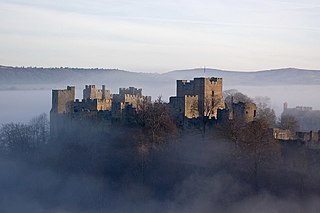
Pain fitzJohn was an Anglo-Norman nobleman and administrator, one of King Henry I of England's "new men", who owed their positions and wealth to the king.
William de Chesney was a medieval Anglo-Norman nobleman and sheriff. The son of a landholder in Norfolk, William inherited after the death of his two elder brothers. He was the founder of Sibton Abbey, as well as a benefactor of other monasteries in England. In 1157, Chesney acquired the honour of Blythburgh, and was sheriff of Norfolk and Suffolk during the 1150s and 1160s. On Chesney's death in 1174, he left three unmarried daughters as his heirs.
Sir Robert Broughton was a landowner, soldier, and Member of Parliament for Suffolk. He was knighted at the Battle of Stoke, where he fought on the Lancastrian side under John de Vere, 13th Earl of Oxford. He was a close associate of the Earl, and is said to have married the Earl's illegitimate daughter, Katherine.
John Spencer was an English courtier and Member of Parliament.
Thomas Sturmy was a 13th-century landowner, nobleman, and household knight for John, King of England.
Robert of Ropsley was an important household knight who had a close relationship with John, King of England
Sir Robert de Berkeley, 3rd feudal baron of Berkeley was an Anglo-Norman baron and justice.